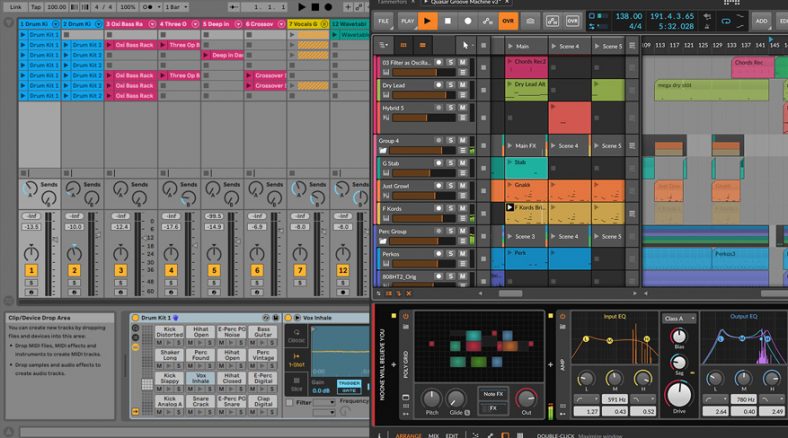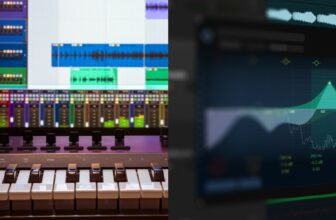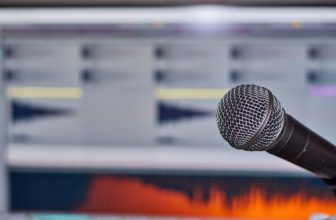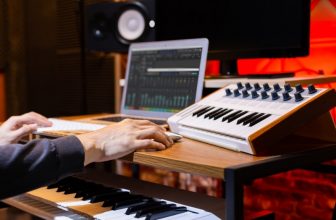The 10 Best DAWs in the World (2024) for Windows and Mac
A DAW is perhaps more essential than any recording gear that you may have. A good one increases productivity and music-making becomes a lot more fun. While every musician or producer has their favorites, some DAWs have seriously stood the test of time.
Picking the right DAW is not an easy choice to make. Here is our pick of the top ten DAWs that you need to know about, in no particular order:
Contents
1. Ableton Live 12
Ableton Live was created by a Berlin-based company Ableton AG and is currently in its eleventh edition. This has become an incredibly popular if not the most popular DAW since it can be used as not just a recording DAW but also for live performances.
Key Features:
- The unique ‘session’ and ‘arrangement’ views that users can toggle between. This makes it a powerful live performance tool.
- Extensive library built, especially for electronic music producers. The stock plugins and VSTs (virtual instruments) are highly customizable.
- Max For Live is a platform that can be used to build your instruments and effects racks.
- Editing, MIDI and automation features are highly intuitive and make post-production a hassle-free process.
- Before you decide to buy the DAW, Ableton lets you download it with full features for a trial period. You can use this time to familiarise yourself with the visual interface and explore it thoroughly before you make a purchase.
Pros:
- Ableton Live is known for being stable and does not have too many crashes, making it reliable for use during live performances.
- Attention to detail such as the ‘swap mode’ to change sounds makes for an efficient workflow.
- Push is a dedicated Ableton Live controller and can be used for writing, recording, and even editing.
Cons:
- The full edition (Ableton Live 12 Suite) is relatively expensive. If you are a beginner, this may not be the best option for you.
- While you can make any type of music with Ableton Live, its workflow was built for electronic music. If you make another style of music, the stock sounds and instruments of another DAW might give you a better head start.
2. Cubase By Steinberg
Steinberg are well known for making “gold standard” audio software products. Cubase has been around for a very long time and is the DAW of choice for many top musicians and composers such as Hans Zimmer, Hildur Guonadóttir, and Chromeo.
Key Features:
- Cubase is used by many composers for film scores and background music composition. Additionally, it can also be used for post-production such as mixing and mastering.
- Groove Agent is a powerful drum software that contains acoustic as well as electronic kits. This can be used for songwriting, beat editing, live sampling, and even for sound design.
- The DAW has powerful editing features such as multi-take comping, rendering in place for audio/MIDI, quantizing and audio warping, time-stretch, etc.
- Control Room emulates a live studio environment and has features such as talkback, monitoring, and mix cues.
- The Scale Assistant in the Key Editor is a handy tool for those without extensive knowledge of music theory. You can use this for scale suggestions when you edit or record.
Pros:
- One of the oldest and most trusted DAWs there is. Steinberg Cubase, currently in its 12th edition has kept the software up to date by incorporating many new features.
- The editing features can be used for professional-sounding mixes and mastering.
- Versatile enough so musicians and producers across all genres can use this as their main DAW.
Cons:
- The traditional visual interface might feel dated when compared to some of the other DAWs available in the market today.
- Steep learning curve and is not the most user-friendly.
- Expensive, if you aren’t necessarily looking for a professional quality DAW.
3. Pro Tools By Avid
If you have walked into the control room of a professional recording studio, chances are they are using Pro Tools as their DAW. Over the years, Pro Tools has become the industry standard since it can support a huge number of tracks without any glitches. Its superior capabilities make it the go-to for producers and mix/master engineers.
Key Features:
- Pro Tools Ultimate supports up to 2048 audio and 1024 MIDI tracks. The feedback from users is that no matter how big a project, this DAW can simultaneously process a lot of information.
- The ‘QuickPunch’ feature makes track comping very efficient.
- Ultimate also supports Dolby Atmos and Ambisonics VR mixing.
- Large plugin library that consists of music creation and post-production tools.
- Avid Cloud Collaboration and Avid Marketplace are handy features for musicians looking for cloud-based project storage and connecting with other Pro Tools users.
Pros:
- Great recording and editing features.
- Can support large projects.
- The industry standard is often considered to be Avid Pro Tools.
Cons:
- More suitable for recording and post-production than songwriting.
- The visual interface is traditional and not very innovative.
- Not user-friendly if you are a beginner.
4. FL Studio By Image Line
Many musicians will tell you that their journey into the world of DAWs started with Fruity Loops and they now use FL Studio (Fruity Loops Studio) for songwriting and recording. Some of the examples are Martin Garrix and Afrojack.
One of the things that separate Image-Line’s FL Studio from the others is also the fact that you get free lifetime updates once you purchase a copy. Unlike others, where you have to pay to upgrade one version to the latest one upon release, FL Studio was created keeping in mind the needs of the semi-professional producer on a budget but with the features of a professional DAW.
Key Features:
- This is a beginner-friendly DAW for electronic music producers who are looking for an uncomplicated interface to make beats and melodies.
- The FL Studio Mobile version lets you create music on the go and later revisit it.
- The Piano Roll is highly efficient and lets you change time signatures mid-patterns using the Playlist.
Pros:
- Easy to use and recommended for beginners and enthusiasts.
- Budget-friendly and the free version can be used for an unlimited period.
- Handy tools for electronic music producers.
Cons:
- Does not have the best post-production tools.
- The user interface can often feel disorganized.
- Unless you dive very deep into learning this DAW, it can often feel not as professional as some of the others available in the market today.
5. Reaper By Cockos
Rapid Environment for Audio Production, Engineering, and Recording (REAPER) was developed for musicians on a budget looking for a simple yet effective DAW. It is a highly customizable software that helps you optimize your workflow.
Key Features:
- One of the features that separates Reaper from the other DAWs is how efficient it is in terms of occupying space on your computer. It takes up only 66MB and is compatible with both Windows and macOS.
- Almost all plugins are compatible with the DAW.
- You can customize your menu to show you only the features you need the most access to.
- Reaper is extremely light and occupies very little space on your computer.
- The DAW is also known for being highly CPU efficient.
Pros:
- This is one of the most budget-friendly DAWs yielding professional-sounding results.
- Great for beginners or musicians who are using a DAW for the first time.
- Very lightweight and does not take up much space on your computer.
Cons:
- Not as innovative and modern as some of the other DAWs. The interface can feel a little dated at times.
- The post-production features can often feel limited.
- In comparison to others, Cockos Reaper offers fewer features overall.
6. Logic Pro By Apple Inc.
No list on DAWs can be complete without the mention of Logic Pro X, which has quickly become a favorite and has many users because it is easy to use and great software for songwriters who are looking to record and produce their ideas with minimal interference.
Key Features:
- The large sound library includes amp and pedal modulators for guitars and basses, exhaustive synth sounds as part of the AU (Audio Unit) plugins.
- The Drummer is an intuitive and customizable drum machine that replicates not just drum machine patterns to suit your song but also features acoustic kits to emulate human drummers.
- The Loop Library is easy to use and has versatile sounds.
- The Score Editor lets you export sheet music in Music XML format.
- Garageband is a free app that can give one an understanding of how Logic Pro works. You can use this on your iPhone, iPad, or any other macOS machine.
Pros:
- This is very user-friendly and has some great piano, guitar, bass sounds, and vocal plugins, making it very easy to get started on a new project.
- A good bank of post-production plugins and the DAW can be used for mixing and mastering purposes.
- Live Loops, which was introduced recently breaks away from the visual monotony of horizontal interfaces. Live Loops is grid-based.
Cons:
- The very obvious ‘con’ of this software is that it is only available for Mac users and Windows/Linux users are left behind.
- Bulky projects can often cause glitches or crashes during playback.
- Despite the new Loops View, it is still not reliable for live performances.
7. Bitwig Studio By ADSR Sounds
Bitwig Studio 5 is a great alternative to Ableton Live users who want to explore for modulation features and are looking for a grid-based visual interface to optimize their workflow.
Key Features:
- ‘The Grid’ is a modular sound design interface that supports 154 modules for quick workflows.
- You can create custom synthesizers and sequenced patches using the ‘Poly Grid’.
- There is also an option to link with Ableton Live users and synchronize the start/stop of your project.
- The ‘FX Grid’ device can be used to create audio effects with optional voice stacking.
- You can assign different colors not just audio sources but note messages as well.
Pros:
- This is the most efficient DAW if you work on modular synthesizers and are looking for a software equivalent.
- You can build your own devices and customize the sounds in all ways possible.
- The option to customize your workflow matches any style.
Cons:
- The learning curve is steep. This is not a DAW for songwriters and producers who are looking for quick and easy-to-use presets to get a project going.
- Although you can arrange and mix your music, the DAW is mostly for electronic music and thus not very versatile.
- The visual interface can be intimidating at the beginning.
8. Reason By Reason Studios
Reason’s popularity dipped due to not being plugin-friendly. But from 2019 onwards, external plugins are now compatible with the DAW. Their Mimic Creative Sampler is a rack device that hardware users enjoy working on.
Features:
- The Reason ‘Rack’ is for instruments, effects, and other utilities. You can use this to set up for instrument chain and also modify and EQ it like a hardware instrument.
- The ‘ReGroove Groove Mixer’ can humanize mechanical playing. This can be especially helpful for electronic music producers.
- The project-wise time stretch changes the tempo of the entire project without any distortions.
- The mixer is modeled after the vintage SSL 9000k analog mixer.
- REX Loops enables you to modify loops to sound more organic.
Pros:
- The ‘Blocks’ feature is handy for songwriters who want to repeat sections to form their song structure.
- The sampler players all have a built-in sampler and sample editor.
- The ‘Combinator’ device lets you customize your panel with buttons, faders, and switches for optimum workflow.
Cons:
- The graphics on the visual interface can still feel dated.
- Reason+ is compatible with other DAWs so it’s not necessary to use the Reason Studio as your default DAW.
- Not as feature-packed as some of the other DAWs available these days.
9. Audacity By The Audacity Team
Audacity is a free DAW that can be especially helpful for beginners or those looking to produce music as a hobby. It is open-source software that is compatible with Windows, macOS, and Linux machines. It’s a great DAW for multitrack recording, beginner editing, and more.
Key Features:
- You can record in either 16 or 24-bit audio.
- The ‘Device Toolbar’ can be used to manage multiple playbacks and recording devices.
- You can capture streaming audio using this DAW.
- Audacity allows you to record multiple channels simultaneously and at sample rates from 192,000Hz up to 384,000Hz.
- You can import and export files in WAV, AIFF, mp3, AU, FLAC, and Ogg Vorbis format.
Pros:
- Easy to use DAW if you want to record vocals for podcasts and game streams.
- The batch processing makes edits and exports a fast process.
- Free to use.
Cons:
- The audio editing tools are sparse and you cannot use the mixing desk for advanced post-production.
- Limited features for instruments and effects. This makes it not very versatile.
- Many plugins are not compatible with this DAW.
10. Studio One By PreSonus
Presonus Studio One is currently in its 6th edition and has great editing tools for those looking for a good post-production DAW. It is easy to use and most major VST plugins are compatible with it.
Key Features:
- You can create drum notations in the ‘Score View’.
- The floating chord displays the chord being played from the Chord Track and the chord to follow. You can import chords from a song using the ‘Send To Show’ option.
- The SoundVariations Editor allows composers to add symbols to their scores. Dynamics symbols are linked to MIDI velocity and have customizable values.
- You can resize your Mixer window to best fit your needs.
- The ‘Autosave’ saves your project at time intervals set by you and this can be especially helpful in case you forget to manually save your projects when making changes to them.
Pros:
- The drag-and-drop workflow makes it easy to set up a project and get started quickly.
- Versatile selection of plugins available.
- The ‘Arranger Track’ makes moving sections of a song very easy.
Cons:
- The sheet music cannot be printed without Notion.
- The time-stretch feature is not very intuitive.
- Visually, the Mixer View can feel overwhelming.
Frequently Asked Questions (FAQs)
What is the best DAW for mixing?
Pro Tools and Cubase are the best DAWs for mixing and mastering. Their workflow is considered to be more complex than other competitors but due to their overall capabilities, they are excellent digital audio workstations for mixing.
What are the best free DAWs?
Garageband is a great free DAW for iOS users. Cakewalk is a very good free DAW for Windows. If you’re interested further, there are many other Free DAWs out there that you can check out.
What are the best DAWs for PCs?
Ableton Live, Reaper, FL Studio, Studio One, and Cubase are all very solid options for Windows. Naturally, it comes down to personal preference and workflow so make sure to do your research before committing to one.
What is the best DAW for a beginner to learn music production with?
Logic Pro for macOS users. Reason is also great for beginners. In essence, you want a user-friendly DAW with a simplistic design and interface so that it doesn’t become too overwhelming while learning music production.
What would be the best DAW for live performance?
Ableton Live or Bitwig Studio. Ableton Live is incredibly popular for live performances, especially for DJs and electronic musicians. If you want to know more, check out How to Perform Live with Ableton Live.
What is the best DAW for music composition?
Cubase and Logic Pro are two of the best DAWs for composing music. That being said, other DAWs like FL Studio, Ableton, and Pro Tools are also good. It boils down to preference and which DAW is most comfortable for you.
Summary
Picking the right DAW can be a hard choice to make. Some of the factors you need to take into consideration are your budget, the computer you want to work on, your skills, and your aspirations. Like any other software, all the DAWs in this list have their advantages and disadvantages. The good news is that most of them offer free trials. If you are unsure, the best thing to do would be to explore the demo version of the interface before you make a purchase. This will tell you what the DAW is about and what its capabilities are.
Many professional musicians also use multiple DAWs to suit their needs. You can choose one for live performance and work on a different one for recording. Remember the most important thing when picking a DAW: the one you find the most comfortable working on is the one for you.








